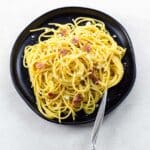Traditional Italian Spaghetti alla Carbonara
Traditional Italian carbonara is classic comfort food at its very best. This recipe uses just a handful of basic ingredients that are easy to keep in the house. I tend to use very good quality American-style bacon because carbonara feels like a pantry meal, and that's what I tend to keep on hand. But there are notes below on how to keep it extra-classic with guanciale or pancetta. Even though carbonara is a basic recipe, the method can be a little intimidating at first. We take the guesswork out of the equation with a simple trick.
Calories: 557kcal
Equipment
Ingredients
- 2 whole large eggs plus 2 egg yolks
- 1 ounce (30 grams) freshly grated Pecorino Romano cheese
- 1 ounce (30 grams) freshly grated Parmigiano Reggiano cheese
- ¼ teaspoon freshly ground black pepper
- 8 ounces (227 grams) guanciale, pancetta, or very thick bacon, diced
- 2 garlic cloves peeled and smashed
- 1 pound (454 grams) spaghetti
Instructions
- In a very large, heatproof mixing bowl, whisk together the eggs and egg yolks, the grated cheese, and the pepper. Set aside.
- Fill a very large pot halfway with water. Add plenty of salt, cover, and bring to a boil. (Proceed to step four at this point, and start cooking the bacon while you wait for the water to boil.) When the water boils, cook the spaghetti one minute less than it says on the package. Do not drain the pasta in the sink — you'll need the cooking water.
- At the same time, add the diced guanciale, pancetta, or bacon and the smashed garlic cloves to a large pan and then set the pan over medium heat. Cook, stirring occasionally, until the bacon is nicely browned and a lot of the fat has been rendered. If there is a lot of fat in the pan, remove most of it, leaving about two tablespoons.
- With the bacon pan set over low heat, carefully stir in ¼ cup of the pasta cooking water, scraping up any browned bits from the bottom of the pan. When the pasta is ready, use tongs to transfer it from the pot to the pan. It's fine if some of the cooking water clings to the spaghetti as you transfer it. (Leave the rest of the cooking water in the pasta pot.) Stir the spaghetti to coat with the bacon fat/water emulsion and cook for a minute, then turn off the heat.
- Give the eggs another good whisk, and then slowly whisk in ¼ cup of the pasta cooking water. This helps to temper the eggs, bringing up their temperature slowly so they won't scramble. When the water is incorporated, tip the entire contents of the pan into the bowl with the egg mixture. Use tongs to stir it all up very well, coating all of the spaghetti strands with the sauce.
- At this point, you'll need to use your judgment a little bit. If all of the sauce clings to the pasta like a nice, creamy, gently thickened coating, you're all set. You can plate the pasta and serve. Often this will be the case — the combined heat of all the dish's elements will be enough cook the sauce.
- If the sauce seems thin and watery rather than silky, set the mixing bowl over the pot of steaming pasta water and toss the pasta constantly with the tongs until the heat from the water thickens the sauce. (If the bowl fits over the pot without touching the water, you can rest it on top — otherwise hold it just above the water with one hand while tossing with the other.) When the sauce is silky and clings to the pasta, you're ready to plate.
Video
Notes
- Ideally you'll use a combination of Pecorino Romano and Parmigiano Reggiano cheeses. Pecorino (made with sheep's milk) is a little bit saltier and tangier, while parmesan is a bit sweeter. A mixture will give you the best characteristics of each and an even richer, more well-rounded final dish. If you only have one or the other on hand, that's fine, too.
- Traditional spaghetti alla carbonara uses guanciale, which is cured pork jowl/cheek. Unlike bacon, it's not smoky. It's sold in both rolled and slab form. If you would like to use it for this recipe, buy it in slab form and dice it. You can also use pancetta, which, like bacon, is from the belly of the pig — but unlike bacon, isn't smoked.
- The beauty of this recipe is its magical, silky sauce, which relies on timing. I recommend making carbonara just before serving. If you need to make your meal ahead of time, choose a different recipe.
- That said, leftovers are delicious, too. They'll keep well in an airtight container in the fridge for two to three days. Reheat on half power in the microwave, in a double boiler, or over very low heat on the stovetop.
Nutrition
Serving: 1 | Calories: 557kcal | Carbohydrates: 37g | Protein: 34g | Fat: 29g | Saturated Fat: 11g | Polyunsaturated Fat: 17g | Cholesterol: 256mg | Sodium: 1203mg | Fiber: 2g | Sugar: 1g
